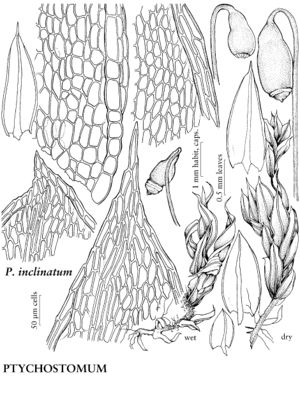Ptychostomum inclinatum
Phytologia 87: 21. 2005.
Plants in dense or open turfs or scattered individuals, green, red-green, or yellow-green. Stems 0.5–2 (–3) cm, tufted, comose, innovations elongate and evenly foliate; often strongly radiculose. Leaves yellow-green to red-green, weakly to strongly contorted or shrunken when dry, ovatelanceolate, weakly concave, (0.6–) 1–2 (–3) mm, enlarged toward stem apex; base not decurrent; margins revolute to mid leaf, limbidium strong, in 2 or 3 rows; apex acuminate; costa long-excurrent, awn smooth to denticulate; proximal laminal cells 3–4: 1, same width or narrower than more distal cells; medial and distal cells rhomboidal, 12–18 µm wide, 3–4: 1, walls thin. Specialized asexual reproduction absent. Sexual condition synoicous. Seta 1–3 cm. Capsule brown, short to long pyriform, symmetric, 2–4 mm, mouth straight, orange or yellow; operculum short-convex, apiculate; peristome somewhat reduced; exostome teeth yellow basally, hyaline distally, lamellae straight to curved mid-tooth, pores absent along mid line; endostome sometimes adherent to exostome, basal membrane high, 1/2 exostome height, segments with ovate perforations, cilia rudimentary or sometimes 1 or 2, long, appendiculate to nodose. Spores (18–) 20–24 µm, finely papillose, pale-yellow or green.
Habitat: Capsules mature Jun-Aug. Dry soil, alpine or arctic tundra, circumpolar arctic-alpine; low to high elevations (0-4400 m)
Distribution

Greenland, Alta., B.C., Nfld. and Labr., N.W.T., N.S., Nunavut, Ont., P.E.I., Que., Yukon, Alaska, Calif., Colo., Idaho, Maine, Mich., Minn., Mont., Nev., N.Y., Oreg., Utah, Wash., Wyo., South America, Eurasia, Antarctica
Discussion
Ptychostomum inclinatum is a widespread common arctic-alpine species, closely related to P. archangelicum, differing in its larger size, occasional presence of cilia, and smaller, paler spores.
Selected References
None.
Lower Taxa
"narrower" is not a number."narrow" is not a number.
